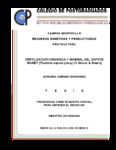| dc.description.abstract | El objetivo de la investigación consistió en estudiar las características físicas y químicas
del suelo cultivado con mamey [Pouteria sapota (Jacq.) H. Moore and Stearn], se
evaluaron cinco tratamientos: vermicomposta 6.6 kg árbol-1, gallinaza 5 kg árbol-1,
fertilizante químico (sulfato de amonio 1 kg árbol-1, superfosfato de calcio triple 750 g
árbol-1, sulfato de potasio 400 g árbol-1), Azufre 4 kg árbol-1 y el testigo. Se hicieron
cinco aplicaciones con cuatro repeticiones por tratamiento. Se determinó el estado
nutrimental de los árboles, mediante el análisis foliar, extracción de macro y
micronutrimentos por los frutos y se estudió la distribución radical. El experimento se
llevó a cabo en Alpoyeca, Guerrero, en árboles de 16 años. Los muestreos de suelo y
foliar fueron: al inicio del experimento y 18 meses después de la primera aplicación de
los tratamientos. EL análisis químico inicial del suelo muestra que éste tiene un pH de
7.7, conductividad eléctrica (C.E) de 0.41 dSm-1 y materia orgánica de 2.95%. Los
niveles de N, K, Mn, Fe y Cu son normales, P y Zn son bajos y Ca, Mg y S son altos. Al
finalizar el experimento, el pH disminuyó ligeramente en todos los tratamientos, con la
aplicación de azufre el efecto en la disminución del pH fue mayor y llegó a 6.70 a los 30
cm de profundidad, mientras que la C.E. aumentó ligeramente en las dos profundidades
(0-30 y 30-60 cm). Los contenidos de M.O. fueron clasificados de bajos a medios. Los
niveles de N se mantuvieron normales en ambas profundidades. Las concentraciones
de P, K, Ca, Mg, S y Zn se consideraron altos, mientras que las de Mn, Fe y Cu
disminuyeron, a excepción del tratamiento con S donde se incrementaron en la
profundidad de 0-30 cm. La mayor longitud y densidad de raíces se tiene a 1 y 3 metros
de distancia del tronco a la profundidad de 0-30 cm. Los macronutrimentos encontrados
en mayor concentración en hojas fueron Ca (20.17 mg g-1), N (16.36 mg g-1) y K (6.81
mg g-1). La cáscara y semilla registraron mayores concentraciones de N, Ca, Mg, Mn,
Fe y Zn superando estadísticamente a la pulpa. Los elementos que extraen en mayor
proporción los frutos de mamey son: K (9.61 mg g- 1), N (6.55 mg g-1) y Ca (1.24 mg g-1).________The objective of this investigation consisted of studying the physical and chemical
characteristics of soil in which mamey [Pouteria sapota (Jacq.) H. Moore and Stearn]
,five treatments with four replications were evaluated: vermicompost (worm compost) 6.6
kg!tree-1, hen manure 5 kg!tree-1, chemical fertilizer (ammonium sulfate 1000 g!tree-1,
triple calcium super phosphate 750 g tree-1, and potassium sulfate 400 g tree-1), Sulfur
4 kg tree-1 and the control with no application; five applications were made per
treatments. Was determined the nutrition status and extraction of macro and
micronutrients by fruits and studied the radical distribution of mamey trees. The
experiment was carried out in Alpoyeca, Guerrero, using 20 16-year old trees. Soil and
foliar samplings were conducted, first at the beginning of the experiment and, second,
18 months after the first application of treatments. In both dates, analyses of leaves and
soil were conducted to determine foliar content and extraction by fruits of macro and
micronutrients. The initial chemical analysis of soil indicated a pH = 7.7, electrical
conductivity (CE) = 0.41 dS!m-1, and 2.95 % of organic matter (O.M). The levels of N, K,
Mn, Fe and Cu soil content were normal, P and Zn were low and Ca, Mg and S were
considered high. At the end of the experiment (18 months later) pH diminished slightly in
all the treatments, with the application of sulfur the effect in the diminution of pH was
greater and arrived at 6.70 to the 30 cm of depth, whereas the CE slightly increased in
the two depths studied, 0-30 and 30-60 cm. The O.M. content was classified from low to
medium. Nitrogen content remained normal in both depths. Soil concentrations of P, K,
Ca, Mg, S and Zn were considered high at the end, whereas those of Mn, Fe and Cu
decreased, exception was made for treatment with S in which these nutrients increased
in the stratum 0-30 cm deep. The greatest length and root density were observed in the
first and third meters from the trunk, between 0 and 30 cm deep. The macronutrients
more abundant in leaves were Ca (20.17 mg!g-1), N (16.36 mg!g-1) and K (6.81 mg!g-1).
The fruit skin and seeds showed greater concentrations of N, Ca, Mg, Mn, Fe and Zn
surpassing statistically the fleshy tissue in fruit. The nutrients with highest extraction
rates by mamey fruit are: K (9.61 mg!g-1) followed by N (6.55 mg!g-1) and Ca (1.24
mg!g-1). | es |


